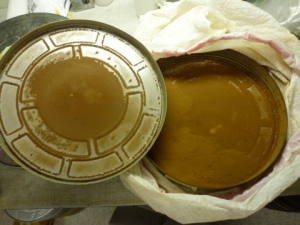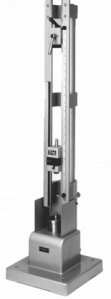Wisconsin Nitrate Film Project
In its final stages of decay – Stage 5 according to the model commonly employed by archivists – nitrate film disintegrates into a “brown powder.”
 The potentially hazardous nature of the brown powder is the source of substantial anxiety in the archive community, as literature and anecdotes about this stage of nitrate film’s decomposition are particularly contradictory. Some, such as International Organization for Standardization’s ISO 10356: Cinematography – Storage and Handling of Motion Picture Films (most recent edition 2012), maintain that the powder is comparable in flammability to paper and so relatively inert. Others, however, such as Eastman Kodak’s legal Material Safety Data Sheet (most recent edition 2010), assert that it is “shock sensitive,” like gunpowder or nitroglycerine.
The potentially hazardous nature of the brown powder is the source of substantial anxiety in the archive community, as literature and anecdotes about this stage of nitrate film’s decomposition are particularly contradictory. Some, such as International Organization for Standardization’s ISO 10356: Cinematography – Storage and Handling of Motion Picture Films (most recent edition 2012), maintain that the powder is comparable in flammability to paper and so relatively inert. Others, however, such as Eastman Kodak’s legal Material Safety Data Sheet (most recent edition 2010), assert that it is “shock sensitive,” like gunpowder or nitroglycerine.
Additional research has also suggested that the brown powder might be formed by a reaction between the film’s cellulose nitrate base and metal storage cans. This further complicates our understanding of the powder’s relationship to nitrate film’s decomposition.
Given that the degree of danger posed by brown powder significantly affects how curators of nitrate collections handle and dispose of film that has degraded beyond any useful condition, we sought to quantitatively evaluate the shock and friction sensitivity of brown powder by direct mechanical analysis. These results could potentially then be used to inform the archival community about how best to handle and transport any brown powder in their collections.
By soliciting various sources, we obtained four samples of brown powder from two geographically diverse major film archives, as described on the Sample Origin & Size page of this website.
To test these samples, we relied on well–established standards and methods. To determine how sensitive potentially dangerous materials are to a variety of conditions they may be subjected to during shipment, the United Nations Recommendations on the Transport of Dangerous Goods: Manual of Tests and Criteria (5th ed., 2009) advises the use of two tests: the BAM Fallhammer Test and the BAM Friction Test.
 The BAM Fallhammer Test, depicted on the left, involves impacting a solid sample with weights of precisely known mass that are dropped from a precisely measured height. Upon impact, the weights impart kinetic energy to the sample. The minimum amount of energy, measured in Joules (J), required for the impact to cause a flash, flame, or explosion can thereby be determined. The test is typically conducted at least five times to ensure reproducibility.
The BAM Fallhammer Test, depicted on the left, involves impacting a solid sample with weights of precisely known mass that are dropped from a precisely measured height. Upon impact, the weights impart kinetic energy to the sample. The minimum amount of energy, measured in Joules (J), required for the impact to cause a flash, flame, or explosion can thereby be determined. The test is typically conducted at least five times to ensure reproducibility.
U.N. recommendations state that materials with a limiting impact energy of ≥ 2 J are too shock sensitive to transport.
 The BAM Friction Test, depicted on the right, involves dragging a porcelain peg of a precisely known mass over a sample on a porcelain plate at a constant rate. Since the mass of the porcelain peg is known, one can calculate the friction force, measured in Newtons (N), exerted upon the material. The lowest force required for flame, flash, or explosion can then be determined. This test is conducted at least six times to ensure reproducibility of the results.
The BAM Friction Test, depicted on the right, involves dragging a porcelain peg of a precisely known mass over a sample on a porcelain plate at a constant rate. Since the mass of the porcelain peg is known, one can calculate the friction force, measured in Newtons (N), exerted upon the material. The lowest force required for flame, flash, or explosion can then be determined. This test is conducted at least six times to ensure reproducibility of the results.
For reference, the UN Manual lists the limiting friction load for dry nitrocellulose (13.4 wt% nitrogen) as 240 N, and the relatively stable explosive TNT has a threshold friction value of 360 N.
Our four samples of brown powder were sent to Chilworth Technology, Inc., a commercial safety and compliance analysis company that routinely conducts BAM Fallhammer tests using an apparatus developed by the Bundesanstalt für Materialforschung und Materialprüfung (BAM or German Federal Institute for Materials Research and Testing, located in Berlin, Germany).
For all four samples, the BAM Fallhammer test demonstrated that the required energy for flame, flash, or explosion was > 60 J, with no change in the sample appearance. Their analyses demonstrated that the samples were “not particularly sensitive to ignition by mechanical impact.”
According to BAM Friction Tests, also conducted by Chilworth, the limiting friction load associated with all four of the brown powder samples was > 360 N. According to Chilworth’s analytical team, these results indicate that these samples are “not sensitive to ignition by friction.”
With the caveat that we tested a limited number of samples with only partially known provenance, our studies suggest that brown powder is non–hazardous.
